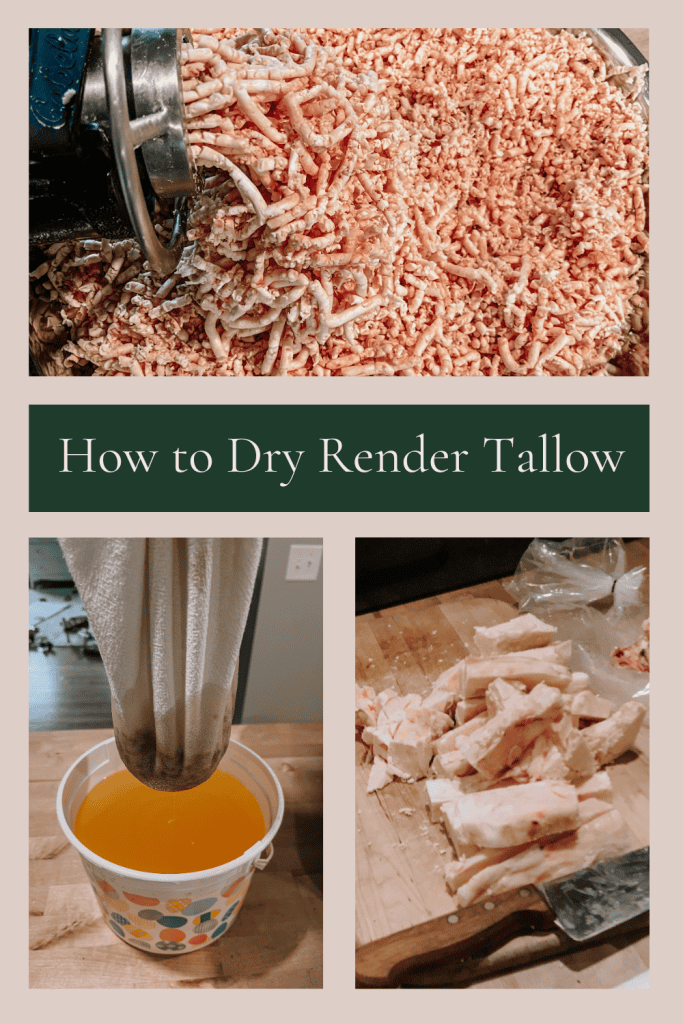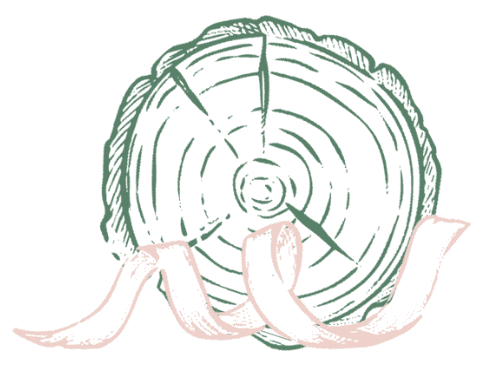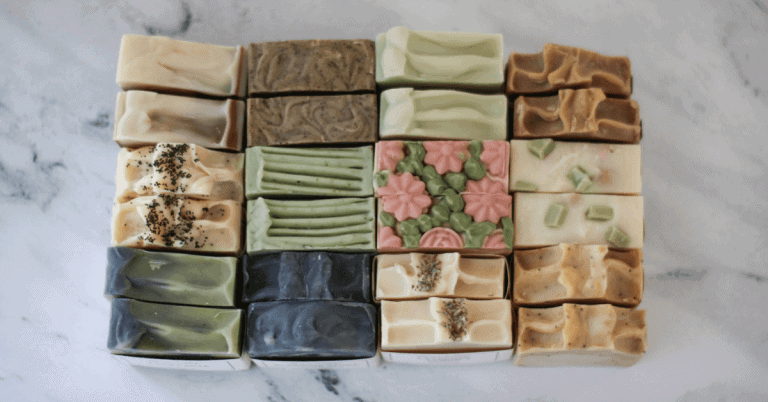How to Dry Render Tallow for Soapmaking
Today I am going to share how I dry render tallow for making soap. Tallow is a versatile and nourishing fat, that can be used for cooking, soap-making, and other body products. It is used in soap-making and body products for its moisturizing properties. I use beef tallow in my handmade soaps for it’s moisturizing properties, and it makes a hard bar of soap that holds up great in the hot sauna and shower (as long as you let it dry out properly between uses!)

What is Beef Suet?
Beef suet is the raw, hard fat around the kidneys of cattle. It is pure, solid fat that has not been rendered yet. When heated up, suet breaks down into a liquid form, and becomes tallow upon cooling.
I choose to render my own tallow for our products because I want to ensure I am using quality products in our artisan tallow soap. You can find beef suet at butcher shops, some grocery stores, online, or your local farmers. I have purchased from butcher shops and local farmers that raise beef cattle.
What is Beef Tallow?
Beef tallow is the rendered, purified outcome of beef suet. It is the final product after melting the raw fat to remove impurities. Tallow is solid at room temperature and has many uses, from cooking to skincare to soapmaking. It is a valuable ingredient in soap making since it adds hardness to the bar, adds a rich lather, and provides moisturizing properties.
Where to Buy Beef Suet?
Before making beef suet, you need quality beef suet. You can check with your local butcher shop, farmers market, or local cattle farmers. You can also purchase online from specialized meat retailers or suppliers.
I would recommend looking for beef suet that is free from additives or preservatives for the best results. If you are checking with local farmers, you can ask for a tour of their farms to see how cattle is being raised, what they are eating, and to build a relationship with your farmer.
I also recommend gifting your local farmer with a bar or two of your handmade soap. Everyone loves handmade soap!
Wet Rendering versus Dry Rendering Method
There are two ways to render tallow. Wet-rendering and dry-rendering. I have done both methods, and prefer to dry render tallow for multiple of reasons.
This is a very personal preference, and if you ask the wrong person, you can open a can of worms that you may not want to know about. If you know what I mean 😉
Wet rendering involves using water and salt to help draw the impurities out of the suet. With wet rendering, you need to follow the process multiple times to remove impurities and then finally remove all of the water from the tallow.
Dry rendering involves just rendering the suet to tallow with no water or salt. And it tends to only need to be processed once.
If you are interested in wet-rendering, here is a great tutorial on how to wet render beef tallow.
How to Dry Render Tallow for Soap
Ingredients & Tools Needed:
- 2-5 pounds of beef suet
- Sharp Knife
- Large Pot or Slow Cooker/ Roaster Oven
- Fine mesh strainer and cheesecloth/ flour sack towel
- Heat-proof jars or containers for storing tallow
Instructions for Dry Rendering Beef Tallow
Trim the suet by removing any meat, gristle, or connective tissue. This will help produce a pure, clean tallow. The cleaner the suet, the less odor and impurities you will have to deal with in the final product.
Cut the suet into small pieces. The smaller the pieces, the better. You can also run it through a meat grinder or food processor to make it even finer. I use a meat grinder, I find that the suet renders quicker and more evenly. And there is less to filter out of the final product.
Placed the ground suet into a into a pot or slow cooker. Using low heat, allow the suet to melt over several hours, stirring occasionally to prevent sticking. I prefer to do the rendering in an 18qt roaster oven on my back porch. I usually do a very large quantity at a time, and it is not the most pleasant-smelling thing ever. So by rendering it outside keeps the mess and smell out of my house. 😊
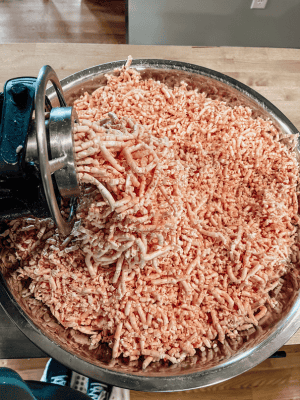
Once the suet has completely melted, there will be cracklings or brown bits floating around. Those need to be strained out using a fine mesh strainer or cheesecloth into heat-proof containers. I like to use flour sack towels for this – they are very large, cheap, and easy to clean. By straining the cracklings out, you are left with clean, pure tallow.
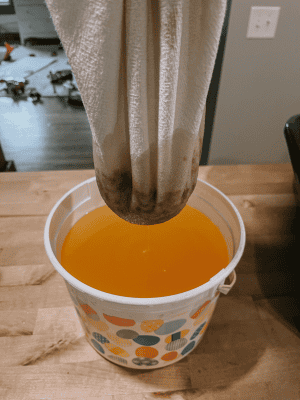
Allow the tallow to completely cool to room temperature. It will solidify into a creamy, white tallow or a slightly yellowish block of rendered fat. Store the tallow in airtight containers, and keep it in a cool, dark area. You can also store in a container in the freezer if you aren’t planning on using it for a while. Properly stored tallow can last a very long time.
Why Use Tallow in Soap?
Using tallow adds multiple benefits to soap. By adding tallow to a soap bar, it creates a long-lasting, hard bar of soap. It contributes to making a rich, creamy lather that can leave the skin feeling soft and moisturized after cleansing. And when it is combined with other ingredients such as organic shea butter and organic coconut oil, it can be gentle and nourishing for all skin types.
And rendering tallow yourself for soap-making (or other skin care products), is a very budget-friendly way to create high-quality bars of soap. With this simple dry rendering tallow method, you can transform your beef suet into a usable ingredient for your handmade skincare and soaping products.
Try a Tallow Soap Bar or Tallow Butter Stick!
We render our own beef tallow to ensure a quality product and with that tallow, we make our tallow soap bars, tallow butter sticks, and more. And we want to share it with you!
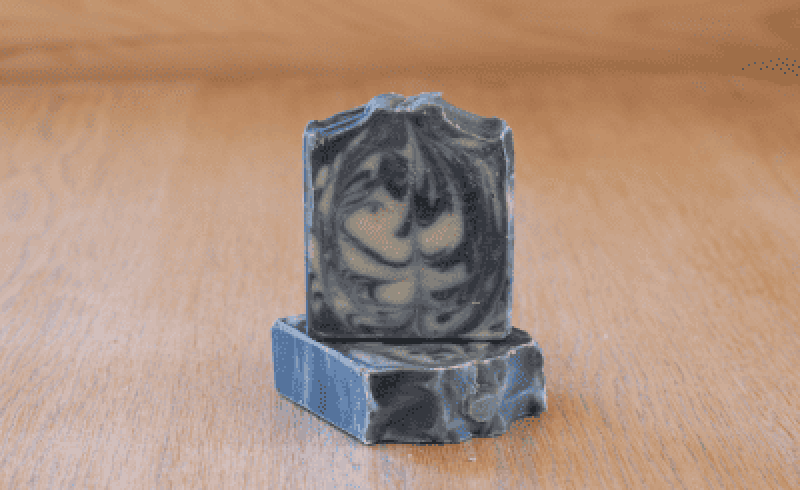
You May Also Like
Homemade Cleaning Spray Recipe
How to Get Rid of Odors in Your Freezer
